10 Most Popular Cheeses Originated in the Middle East

Cheese is a universal language spoken with fervor and delight in every corner of the globe. It’s the versatile hero that can transform a simple dish into a culinary masterpiece or stand alone as a gourmet indulgence. One region that has a rich and often overlooked cheese-making tradition is the Middle East.
This area, steeped in history and culture, has introduced a variety of cheeses that have become essential components of traditional and contemporary cuisine alike. From the humble breakfast tables of rural villages to the bustling urban eateries, these cheeses are not just food items, but a testament to the region’s culinary legacy.
The 10 Most Popular Middle-Eastern Cheeses (BEST)
| Cheese | Country of Origin | Short Description | Tasting Profile |
|---|---|---|---|
| Labneh | Middle East (prevalent in Lebanon) | A soft cheese made from strained yogurt, popular in Middle Eastern cuisine. | Light and refreshing with a tangy flavor, similar to Greek yogurt but creamier |
| Ackawi | Palestine (Acre) | A white cheese traditionally made from cow’s milk. It has a smooth texture and mild flavor. | Mild with a slightly salty flavor |
| Nabulsi (or Naboulsi) | Syria/Lebanon | A semi-hard cheese produced from sheep or goat’s milk, known for its salty taste. | Salty with a hint of spiciness |
| Jibneh Arabieh | Middle East | A soft and creamy cheese that’s often used in pastries and desserts. | Mild flavor with a slight tanginess |
| Testouri | Tunisia | A traditional Tunisian cheese made from sheep or goat’s milk. | Mild flavor with a slight tanginess |
| Basket Cheese | Middle East | A simple, fresh cheese often made in a basket, which gives it its name and distinctive shape. | Mild and slightly salty, with a creamy texture |
| Shanklish | Levantine region | A type of cow’s or sheep’s milk cheese, typically formed into balls and covered in za’atar. | Strong and tangy, with a crumbly texture |
| Domiati | Egypt | A popular cheese made from buffalo’s milk or a mixture of cow’s and buffalo’s milk. | Soft texture and mild taste |
| Areesh | Egypt | An ancient cheese made from laban rayeb, a form of yogurt. | Tangy and slightly salty, with a crumbly texture |
1. Labneh
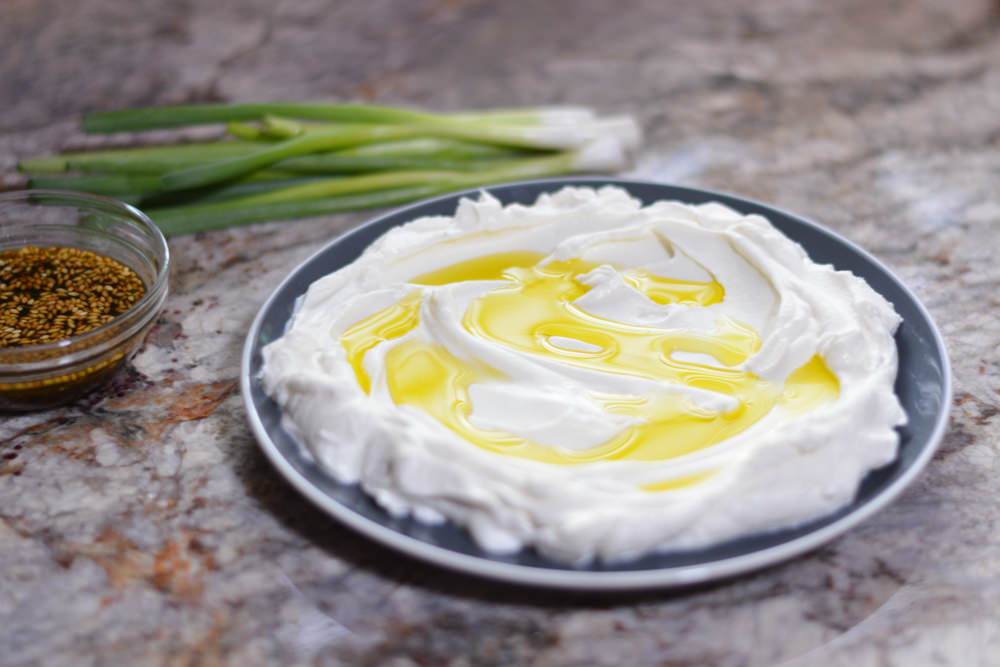
- Milk Type: Made from cow’s milk yogurt that has been strained to remove whey.
- Taste: Tangy flavor similar to Greek yogurt but creamier.
- Texture: Smooth and creamy, spreadable consistency.
- Food Pairing: Often served with olive oil, za’atar spice mix, and warm bread. It can also be used in salads or as a dip for vegetables.
- Wine Pairing: Pairs well with crisp white wines like Sauvignon Blanc or light-bodied reds like Beaujolais.
- Read in-depth guide
Labneh is a traditional Middle Eastern cheese known for its soft, creamy texture and tangy flavor. It’s made by straining yogurt to achieve a cheese-like consistency, resulting in a rich, thick, and creamy spread. While it’s often compared to Greek yogurt, Labneh stands out due to its unique preparation process and distinct taste.
It’s a versatile ingredient that can be used in various dishes or enjoyed as a standalone snack, often garnished with olive oil. Moreover, it’s an excellent source of protein and is low in fat and sugar, making it a healthier alternative to cream.
2. Ackawi
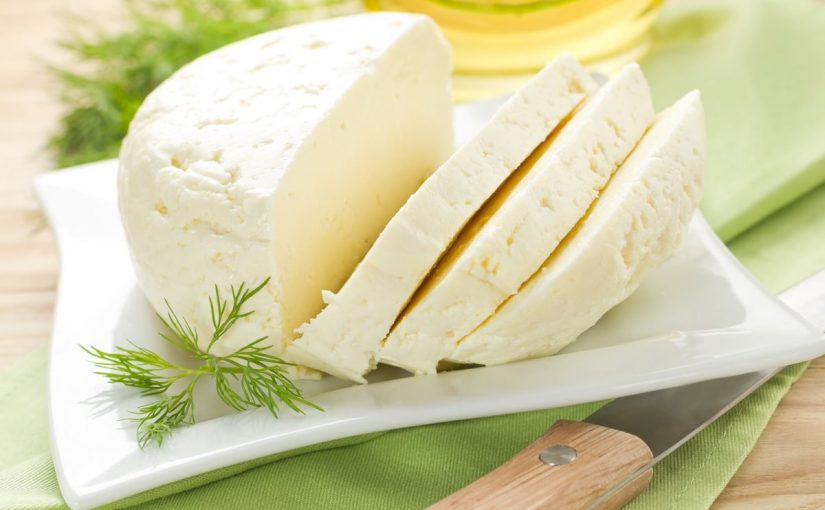
- Milk Type: Traditionally made from cow’s milk.
- Taste: Mild with a slightly salty flavor.
- Texture: Semi-hard, smooth and elastic.
- Food Pairing: Can be eaten as is, or used in cooking for pastries and desserts.
- Wine Pairing: Pairs well with light-bodied red wines like Pinot Noir or fruity white wines like Riesling.
Ackawi, also known as Akawi or Akkawi, is a traditional white brine cheese originating from the Middle Eastern regions of Syria, Lebanon, and Palestine. The name ‘Akkawi’ translates to ‘from Akka’, a city currently known as Acre in present-day Israel. This cheese is renowned for its mild, slightly salty flavor and a firm, smooth texture that offers a pleasant chewiness.
Ackawi is considered one of the oldest cheeses produced in the Mediterranean region and holds the title of the best-selling Middle Eastern cheese. It’s often consumed fresh and is a popular choice for various dishes due to its versatile nature. Ackawi cheese is usually made from cow’s milk, and versions of it are available in a brine jar or as whole milk cheese, ensuring it’s preserved and maintains its distinctive taste.
3. Nabulsi (or Naboulsi)
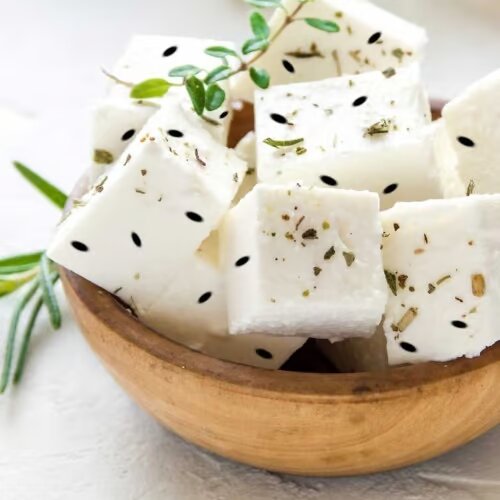
- Milk Type: Produced from sheep or goat’s milk.
- Taste: Salty taste with a hint of spiciness.
- Texture: Semi-hard and elastic.
- Food Pairing: Often used in pastries, it can also be fried or grilled.
- Wine Pairing: Complements well with medium-bodied red wines like Merlot or aromatic whites like Gewürztraminer.
Nabulsi cheese is a traditional white-brined cheese that originates from Nablus, Palestine. It’s typically crafted from sheep’s milk, although goat’s milk can sometimes be used. This cheese is renowned across the Middle East, particularly in Syria. Nabulsi cheese is characteristically salty, often requiring soaking in water before use to temper its saltiness.
Its dense texture and savory freshness make it one of the most palatable and traditional cheeses in the Mediterranean region. Nabulsi cheese is versatile and can be enjoyed as is, fried, or even incorporated into various dishes. The cheese is usually available in a brine jar for preservation, adding to its distinctive taste profile.
4. Jibneh Arabieh
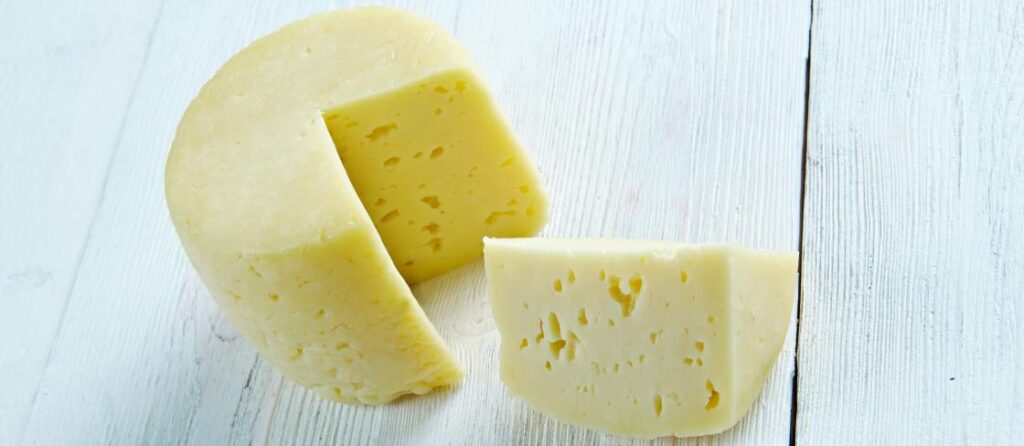
- Milk Type: Typically made from cow’s milk.
- Taste: Mild flavor with a slight tanginess.
- Texture: Soft and creamy, similar to mozzarella.
- Food Pairing: Used in a variety of dishes, including pastries, sandwiches, and salads.
- Wine Pairing: Pairs well with light-bodied white wines like Pinot Grigio or Chardonnay.
Jibneh Arabieh, often simply referred to as Jibneh or Jibni, is a semi-hard white cheese widely appreciated across the Middle East. Originating from Israel, it’s particularly popular in Egypt and the Arabian Gulf area. Originally crafted from goat’s or sheep’s milk, today’s Jibneh Arabieh is predominantly made from cow’s milk.
This cheese is characterized by its open texture and mild taste, making it a versatile addition to various dishes. It stands out due to its simplicity and ubiquitous presence in the Middle Eastern culinary scene. Whether enjoyed on its own or incorporated into recipes, Jibneh Arabieh adds a delightful touch of tradition to any meal.
5. Testouri
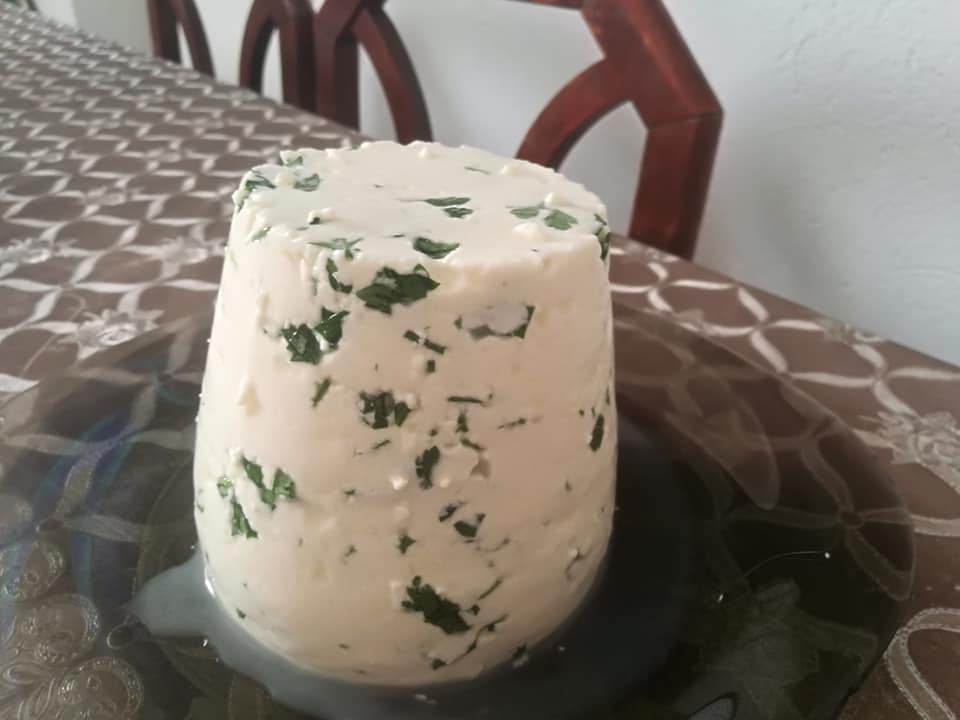
- Milk Type: Made from sheep or goat’s milk.
- Taste: Mild flavor with a slight tanginess.
- Texture: Soft and crumbly.
- Food Pairing: Used in traditional Tunisian dishes, it can also be eaten as is or used in salads.
- Wine Pairing: Complements well with medium-bodied red wines like Cabernet Franc or fruity white wines like Chenin Blanc.
Testouri cheese is a traditional North African cheese predominantly consumed in Tunisia. It’s often crafted from sheep’s or goat’s milk, which gives it its unique flavor profile. The cheese is characteristically shaped like an orange and is enjoyed fresh with a light salting.
Testouri cheese is popular throughout the day in Tunisia, being a part of breakfast, lunch, and dinner. Introduced into North Africa by the Ottomans after the 15th century, it has since become a staple in the region. Interestingly, recent studies have explored its probiotic properties, further enhancing its health-promoting benefits.
6. Basket Cheese
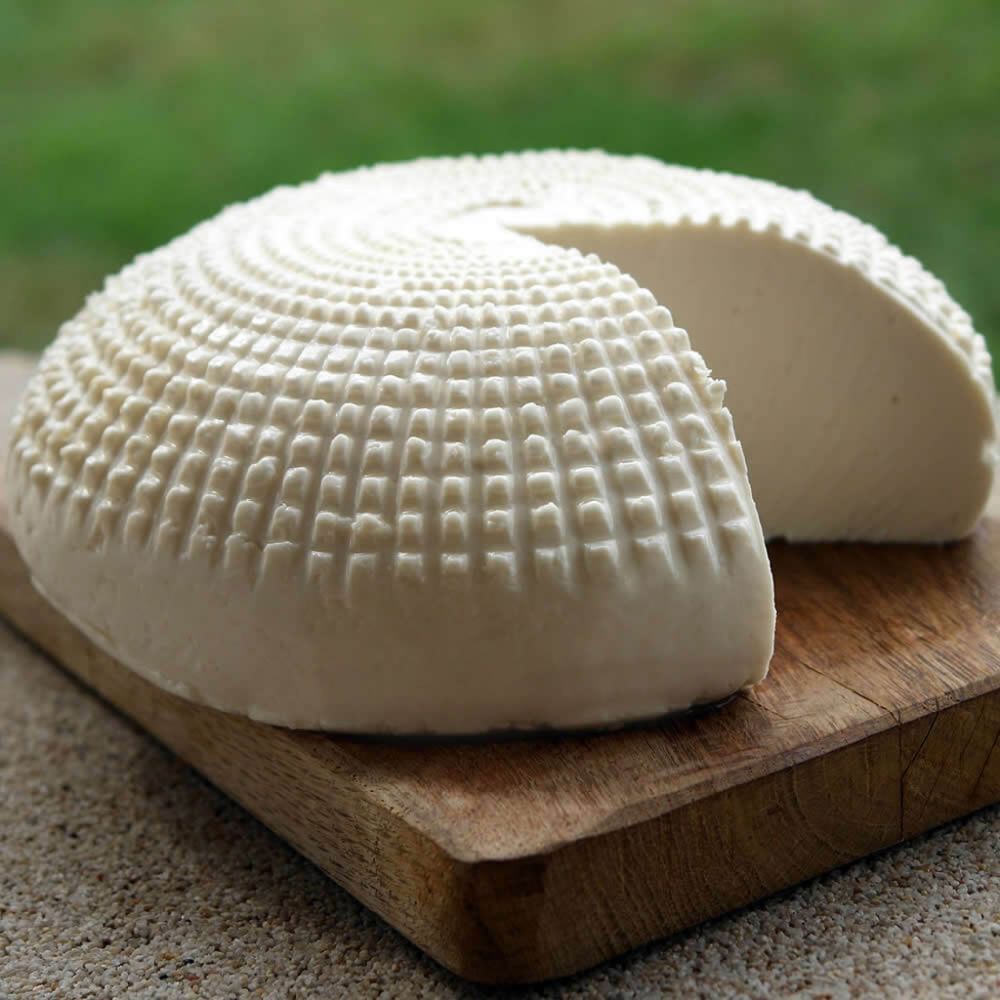
- Milk Type: Traditionally made from cow’s milk.
- Taste: Mild and slightly salty.
- Texture: Semi-soft, creamy, and moist with a shape of the basket it’s formed in.
- Food Pairing: Can be used in salads, sandwiches, or served with fruits.
- Wine Pairing: Pairs well with light-bodied white wines like Pinot Grigio or Sauvignon Blanc.
- Read in-depth guide
Basket Cheese is a Middle Eastern-style cheese that is soft, white, and mildly salty. It’s distinguishable by its unique basket shape, which is achieved by molding the cheese in wicker-textured baskets. The cheese is made from pasteurized cow’s milk and vegetable rennet.
It has a delicate, fresh taste that is a delicious cross between mozzarella and ricotta cheeses. The mild flavor of Basket Cheese makes it highly adaptable, as it can easily take on the flavors of the ingredients with which it’s paired.
The cheese is also used in the Italian dairy tradition, particularly in the form of Sicilian Canestrato. Its smooth, soft, and delicate texture, along with its faint flavor of curds, makes it an enjoyable addition to various dishes.
7. Shanklish

- Milk Type: Typically made from cow’s or sheep’s milk.
- Taste: Strong and tangy, sometimes spicy if rolled in chili flakes.
- Texture: Dry and crumbly when aged, softer when fresh.
- Food Pairing: Usually crumbled over salads or served as a meze with olive oil and tomatoes.
- Wine Pairing: Complements well with aromatic whites like Viognier or medium-bodied reds like Merlot.
Shanklish is a flavorful cheese that hails from the culinary traditions of Lebanon and Syria. It’s a type of blue cheese made primarily from sheep or cow’s milk. The cheese undergoes an aging process, often up to a month long, which helps develop its distinct and delightful flavor. As the cheese matures, it acquires a smoother texture. Shanklish is popular in coastal and mountainous areas and is the Middle Eastern equivalent of blue cheese. One unique aspect of Shanklish cheese is its preparation method involving boiling yogurt on a low fire to separate the whey, adding hot chili and salt, and shaping it into small balls. These are then often coated with herbs and spices for additional flavor. This cheese is versatile and can be used in a variety of dishes, including being paired with zaatar, a popular Middle Eastern spice blend.
8. Domiati

- Milk Type: Made from buffalo’s milk, cow’s milk, or a mixture of both.
- Taste: Salty due to being preserved in brine.
- Texture: Soft and creamy.
- Food Pairing: Often eaten fresh with bread or used in cooking.
- Wine Pairing: Pairs well with crisp white wines like Vermentino or light-bodied reds like Beaujolais.
Domiati cheese, also known as “gibna bayda” or white cheese, is a soft, salty cheese that originates from Egypt. This cheese is also popular in Sudan and other Middle Eastern countries. Domiati cheese is unique in that it is pickled and contains 5.4%–9.5% sodium chloride. It is primarily made from raw or pasteurized cow’s and buffalo’s milk with the addition of 10-14% salt before renneting.
It’s worth noting that Domiati cheese makes up 75% of the cheese produced and consumed in Egypt. Despite being made traditionally from raw milk without the addition of any starters, most of the bacteria identified as dominant in this cheese belong to lactic acid bacteria (LAB), which gives it its distinctive taste. Today, Domiati cheese is widely available in various forms, with its Danish variant being particularly popular.
9. Areesh
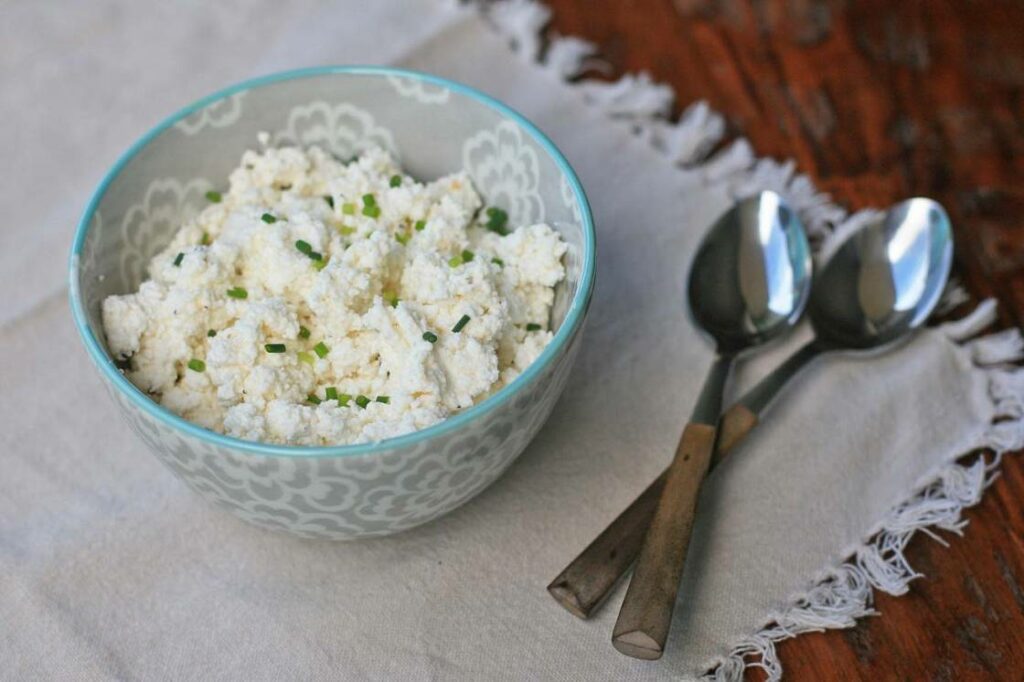
- Milk Type: Produced from laban rayeb, a form of yogurt made from cow’s milk.
- Taste: Tangy and slightly salty.
- Texture: Crumbly and soft.
- Food Pairing: Used in a variety of dishes, including pastries and desserts.
- Wine Pairing: Complements well with fruity white wines like Riesling or light-bodied red wines like Pinot Noir.
Areesh cheese, often compared to cottage cheese in terms of texture and appearance, is a traditional Egyptian delicacy. Known for its health benefits, this cheese is low in calories, easy to digest, and does not contain sugars. Areesh cheese is made from yogurt, and slowly processed to achieve its unique consistency.
The taste of Areesh cheese is subtle and mild, making it a versatile ingredient in many dishes. It’s often described as a cross between ricotta and feta cheese, but without the salt and with a spongier, drier texture. This cheese is an excellent addition to salads and pasta dishes, and can also be used as a spread. Some even enjoy it as a simple, old-fashioned dessert drizzled with honey.
Final Thoughts
As we journeyed through the rich tapestry of Middle Eastern cheesemaking, we discovered a world filled with diverse flavors and textures, each cheese bearing its own unique story and cultural significance. From the universally loved Basket Cheese to the simple yet versatile Jibneh Arabieh, popular in Egypt and Eastern Arabia, these cheeses have left an indelible mark on global cuisine.
The popularity of these Middle Eastern cheeses is a testament to their versatility and unique flavor profiles. They bring a distinctive taste of the region to our tables, adding depth and character to a wide array of dishes. So whether you’re spreading creamy Labneh on your morning toast, or indulging in the semi-hard Naboulsi, you’re not just enjoying a slice of cheese, but a piece of the Middle East’s rich culinary heritage.
Also read:





